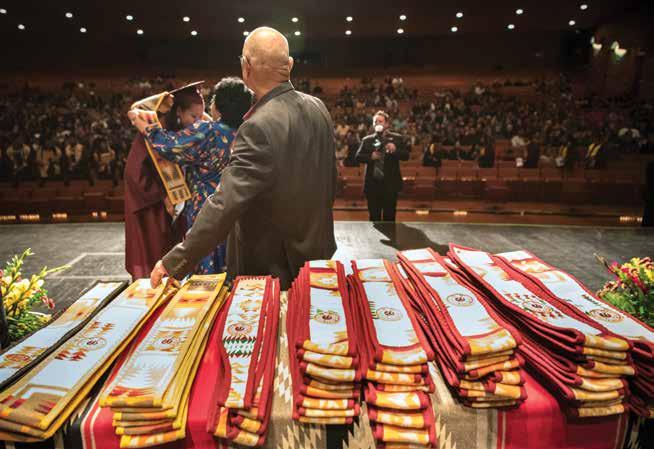
2 minute read
We’re still here: Invisibility
Lejend: During my freshman year, a professor “traditional” and “decolonized” we really are. We failed to include Natives in the discourse surrounding know not to speak on behalf of all Natives because social and political issues. In class, I mentioned to the Native peoples are diverse, and our understanding of professor that Native issues were missing from the this knowledge is ever-growing and changing. discussion. He responded with, “It was a long time Despite the crushing reactions to invisibility, we ago.” I felt inadequate, invalidated and embarrassed. refuse to be silenced. Our ancestors and mentors I felt discouraged to bring up the absence of Native have taught us positive ways to reclaim our identities peoples ever again. and voices. This means that we must take care of
Megan: Tabling at a resource fair for an American ourselves. One way is by visiting with counselors Indian student organization, most students veered (eoss.asu.edu/counseling) or talking to close away from the table, reading the organization’s mission friends and family who we know will support and with a confused look on their faces. Then, a group of revamp the love we have for ourselves. Another way non-Native students came by and is surrounding ourselves with asked about the organization. “Our ancestors our Native student community I explained, “We support our American Indian students in their and mentors have to learn from each other. The American Indian Student Support cultural heritages and academic endeavors.” Another confused taught us positive Services (AISSS) (aisss. asu.edu) is a great place for look. I began sharing upcoming events with them, when one ways to reclaim that. We also work to combat misrepresentations of Native student finally said, “I thought you were all gone.” My stomach our voices and communities to raise awareness of Native peoples and gain the dropped. Shaken, I replied, “We’re still here.” identities.” skills we need to improve the institution. We do this through
Advertisement
These are experiences in involvement with Native student college that made us feel invisible. Invisibility is defined organizations at ASU (aisss.asu.edu/studentby Bryan Brayboy as “the constant interplay between organizations) and in broader organizations that visibility and invisibility-both managed and unmanaged, pique our interests. both within our control and out of our control, and Our experiences as college students and urban the ways institutions, historical contexts and societal Navajo women has impacted the way we envision structures interplay with our daily lived realities.” the future. Native writer Leanne Simpson’s words
Invisibility is also felt in Native specific inspire us to consider a future where we discontinue spaces. As urban Navajo students, we have the “division between reserve and city” to see learned to navigate multiple spaces on campus that “we are all related,” and to remember that no with mindfulness. Not speaking Navajo fluently matter where we are, we’re on Indigenous land. By and growing up in the city are our realities that strengthening our relationships with each other we sometimes invoke debate about our Native identity. hope to strengthen nations and build movements We’re sometimes challenged with proving how that address the challenges of our Native nations.

(Photo courtesy of Alexus Richmond/Turning Points Magazine.)









